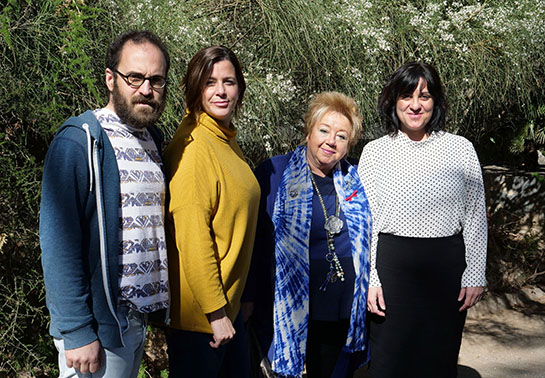
Researchers of the Cavanilles Institute of the Universitat de València (ICBiBe), at the Parc Científic, have just concluded that certain geological and climate events described for the Mediterranean during the Miocene were essential for the shaping of genetic diversity of fungi biota. The research provides new biogeographical data about the origin and diversification of lichenous species adapted to extreme conditions.
A research team run by the professor of Botany of the Universitat de València, Eva Barreno, in collaboration with the Mycology Department of the Royal Botanical Garden of Madrid, has just published an article at the Journal of Biogeography in which they analyse the possible factors involved in the actual distribution of terricolous fungi in the Mediterranean Basin and the Canary Islands. The article is signed by the researchers Salvador Chiva, Isaac Garrido, Patricia Moya, Arantzazu Molins and Eva Barreno.
For the fulfilment of this project, they chose Buellia zoharyi Galun, a terricolous fungi extensively distributed around the Mediterranean Basin and the Canary Islands. The purpose of the project was to analyse the time frame and the climate, geological and ecological factors that may have had an influence in the origin and distribution of this species. The research was carried out with specimens from all over the distribution area of this species, from the Canary Islands to Iran. They performed analysis of population genetics and molecular dating. The research reveals the low genetic diversity found in this lichen and the presence of two haplogroups separated genetically and geographically (south of the Iberian Peninsula, Canary Islands and Morocco vs the rest of the Mediterranean Basin), apart from the presence of a contact area between the two groups in the Iberian Peninsula and the Balearic Islands. The dating analysis that has been carried out using three calibration strategies has allowed to estimate the moment of separation of B. zoharyi and her cryptic species B. elegans Poelt from the Eocene to the Pliocene and the diversification of B. zoharyi from the Miocene until the Pleistocene.
This phylogeographic research shows the original starting point of the historic and ecological factors that potentially affected the evolution, in space and time, of the lichenicolous fungus on biocrusts in the Mediterranean region. More generally, it is postulated that some geological and climatic events described for the Mediterranean during the Miocene, such as the ‘Messinian Salinity Crisis’ and the following ‘Zanclean Flood’, were essential to shape the genetic diversity of biota that is developed over gypsiferous soils, due to the increase of availability of these soils and the progressive aridity of the region. This model coincides with the ones obtained for some vascular plants of the Mediterranean and Macaronesian regions. In some of the studied places, the populations of this species are gravely endangered as a consequence of the impact of tourism and the trampling on these areas, in particular in Lanzarote and Fuerteventura. For this reason, they should be included in the Red List of Ecosystems so that they can be protected and preserved.
The research, carried out by the GIUV, ‘Simbiosis, Diversidad y Evolución en Líquenes y Plantas: Biotecnología e Innovación’ of the Universitat de València and the research team ‘Biodiversidad Vegetal y Ecofisiología’ of the ICBIBE, was sponsored by the Ministry of Economy and Business (MINECOFEDER_CGL2016-79158-P) and the Generalitat Valenciana, through the Excelencia en Investigación programmes PROMETEO/2017/039 and PROMETEOII/2013/021, as well as backup from the IDIFEDER/2018/051 grants.
Reference
https://onlinelibrary.wiley.com/doi/epdf/10.1111/jbi.13519
DOI: 10.1111/jbi.13519
How did terricolous fungi originate in the Mediterranean region? A case study with a gypsicolous lichenized species.
Running title: Phylogeography of a gypsicolous lichen.
Authors: Salvador Chiva1, Isaac Garrido-Benavent2, Patricia Moya1, Arantzazu Molins1 & Eva Barreno1
1Universitat de València, Fac. CC.Biológicas, ICBIBE, Botánica, Burjassot,Valencia, Spain.
2Department of Mycology, Royal Botanical Garden (RJB-CSIC), Madrid, Spain.


Reference:
https://onlinelibrary.wiley.com/doi/epdf/10.1111/jbi.13519
DOI: 10.1111/jbi.13519
How did terricolous fungi originate inthe Mediterranean region? A case study with a gypsicolous lichenized species.
Running title: Phylogeography of a gypsicolous lichen.
Authors: Salvador Xiva1, Isaac Garrido-Benavent2, Patricia Moya1, Arantzazu Molins1 & Eva Barreno1
1Universitat de València, Fac. CC.Biològiques, ICBIBE, Botànica, Burjassot,València, Spain. 2Department of Mycology, Royal Botanical Garden (RJB-CSIC), Madrid, Spain.
Links:








